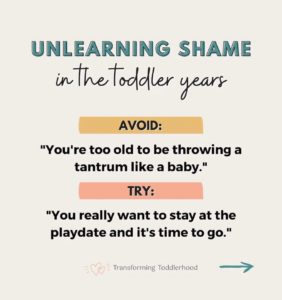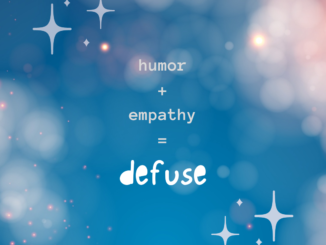It’s confusing to be a toddler. Toddlers often want to be “big kids” and be grown up (especially if they have older siblings)…but they may also really want to be “babies” and be taken care of (especially if they have younger siblings). They may go through long phases of wanting one or the other for days or weeks at a time, or they may shift between wanting to be “big” and wanting to be “little” and varying each hour.
Using their age as a motivator can sometimes really backfire or feel hurtful to a child if they’re struggling to meet an expectation that’s being placed on them. Trying to be independent is the big developmental hallmark of this age. Trying to be connected and close to their caregivers is still the biggest driving human need, and what makes them feel secure.
Well-meaning adults—just trying whatever tools they (the adults) have available—might think that they’re appealing to something meaningful to the toddler when they say things like, “Don’t you want to X? Big boys X,” or, “You don’t need to Y. Only babies Y and you’re not a baby.” But what they’re really doing is poking at their child’s biggest internal emotional struggle in a way that can plant the seeds of shame.
***
Imagine an area where you feel two very poignant and very conflicting desires. Imagine you have the opportunity to get a break, leaving your kids with a trusted and caring babysitter; but that day is a particularly hard day for your child (or one of your children), and when the time comes to leave, the child is begging you not to leave.
You might have two conflicting, powerful emotions inside of you. You love your children very much and you want to meet their needs. You also very much want a break and want to get to go on with the plans you had for the day. You might feel deeply both ways.
Now imagine somebody comes along and says, “Don’t you want to leave? Go on, go. You need to get out of the house, stop coddling him.” Or, vice versa, “You’re not going to leave him, right? Only terrible parents would leave their child when they’re child is feeling this way, and you’re not a terrible parent, right?”
Somebody voicing the two halves of your emotional struggle with a shameful spin on them might provoke different reactions in you. It might make you want to lash out and do the opposite of what they’re saying. Or it might pressure you to cave in and do what they’re saying (stay or go), but now you feel resentful and feel like you’re doing it because of them, not because you worked through your own internal struggle of conflicting emotions and desires in a way that would resolve and feel authentic to you.
***
Instead of making your toddler feel like their age is an indicator of how “good” they’re being (i.e., being “good” is being “older” and being “bad” is being “younger”)…try describing what’s going on for them without any moral judgments about their age. After all, it’s not a moral judgment to be a baby. Babies just are babies, that’s what they are. There’s no shame in that.
And as we describe and name what’s going on inside of our child, we may not flip a magic switch that makes them do what we wish they would do…but we give them language to be able to describe it to themselves.
There shouldn’t be shame in being 2 and needing to be taken care of. (Or 3 or 4 or 15 or 25 or 75, we all need care sometimes!)
Nor should there be shame in being small and trying very hard to be autonomous and independent.
The struggle between wanting to be “big” and “little”, between wanting to be independent and cared-for, is the most powerful internal struggle of this age. It’s okay to acknowledge and be there for our kids as they work through that on their own! We don’t need to add our voices of shame to the background of the work that they’re already doing. <3

[Image description: A post by Transforming Toddlerhood with Devon Kuntzman. The title of it is, “Unlearning Shame in the toddler years.”
It suggests, “Avoid: ‘you’re too old to be throwing a tantrum like a baby’. Try: ‘you really want to stay at the playdate and it’s time to go.’” The words ‘avoid’ and ‘try’ are highlighted with yellow and red so that they stand out. At the bottom is the Transforming Toddlerhood logo, their name with two overlapping hearts. (There is a right arrow as this image was originally taken from a photo series, but I only saved the one image as a short visual example of what I was talking about!) End description.]



